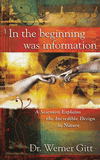
Cosmos Review: “The Immortals”
Episode 11 of Cosmos: A SpaceTime Odyssey
Cosmos Articles and Discussion Guides
See Cosmos: A SpaceTime Odyssey for reviews of other episodes and discussion guides for further study.
“The Immortals,” episode 11 of Cosmos: A SpaceTime Odyssey, exploits the metaphorical value of Noah’s Ark in a series of evolutionary themes while, not surprisingly, treating the biblical account as just a spin-off of the ancient Epic of Gilgamesh. Though admitting that evolutionists do not know how life could have evolved from lifeless elements through naturalistic processes, Cosmos host Neil deGrasse Tyson assumes that it did. Then he weaves tales of how primordial life-forms could have found an ark of safety through Earth’s presumed history of multiple catastrophic surface-destroying collisions.
“Must We Die?”
“Must we die?” asks Tyson as the episode opens. The opening words point to the motivation of Gilgamesh in the famous ancient Akkadian epic. Gilgamesh, the hero of the tale that includes one of the oldest flood legends to be written down, searches for immortality. But the question expresses a concern unique to human beings. We humans are aware that we will die, concerned about what will happen to us after we die, and interested in leaving some sort of legacy marking our significance to future generations. Some people blame God for the death and suffering that intrude upon our lives.
By understanding our true history we can understand the origin of suffering and death. God created a perfect world but warned Adam that disobedience would result in death. Man rebelled, and therefore we must die (Romans 5:12–21) and face our Creator (Hebrews 9:27–28). However, eternal life is given to everyone who repents and trusts in the sacrificial death of God’s Son Jesus Christ (John 3:16–18; John 3:36; Romans 3:23; 6:23).
With the written word we can preserve our thoughts and share them with future generations. Tyson describes this as a sort of immortality. Yet thanks to the written Word of God in the Bible, the good news of how to obtain eternal life is available to people all over the world.
Writing and Cities
After the global Flood about 4,350 years ago, humans—the descendants of Noah’s family—got the opportunity to once again civilize the world. Defying God’s command to spread out, they initially confined themselves to Mesopotamia, as described in Genesis 10 and 11. Therefore, after the Lord confused languages and forced the people to disperse from the Tower of Babel,1 civilization already had a head start in the “land between the rivers.”
In the post-Flood world, the first cities were built in this region (Genesis 10:10). The people descended from Noah’s family were intelligent and literate. They left written records of their presence—poems, school exercises, trade notes, and so on. Tyson claims ancient Mesopotamian places “invented” cities and writing. Yet only evolutionary thinking would deceive us to think that the pre-Flood people lacked intelligence, literacy, and complex social structure—yet Adam was even credited with a book that is mentioned by Moses (Genesis 5:1).
The book of Genesis, written by Moses under the inspiration of God, reports some pre-Flood history. Moses, as he recorded the early history of man, may well have had access to copies of records of pre-Flood genealogies preserved by Noah. The first recorded city was built by Cain, according to Genesis 4:17. The Bible records that those early generations made musical instruments, worked iron, and were highly skilled (Genesis 4:21–22). Ancient Mesopotamia was simply the first place where civilization restarted after the global Flood.
Gilgamesh and Noah
The Epic of Gilgamesh contains one of the hundreds of flood legends that abound in cultures all over the world. These legends are ubiquitous because all people in the world are descendants of Noah’s family, the only people to survive the global Flood.
The biblical global Flood happened about 4,350 years ago. The Epic of Gilgamesh, which contains a distorted account of the Flood, was written down in Mesopotamia, in the general region from which Abraham came. And it was probably written down on clay tablets at a time closer to Abraham’s day than to Moses’ time. Moses, inspired by God (2 Peter 1:21), wrote down the authentic account of the Flood, and it is preserved in the book of Genesis. Tyson asserts that the Akkadian epic, because it was written earlier than the Mosaic account, was the source of the Old Testament account. However, the source was the shared history of a real global Flood, not a shared piece of literature.
There is no justification for supposing the true history in the Bible to be a spin-off of the Gilgamesh epic.
The biblical historical account, recorded under the inspiration of God by Moses, is completely believable in all its details. This genuine history in Genesis 6–9 and the distorted version adapted from Sumerian legends and preserved in the Akkadian Epic of Gilgamesh report on the same historical event. Therefore, the fact that there are some similarities is easily understood.
In contrast to the Gilgamesh epic, the authenticity of the biblical account is supported by internal consistency of the Scriptural account, the consistency of the Scriptural account with the worldwide geological evidence of the Flood, the scientific confirmation of the biblical global Flood in every detail, and the consistency of the Scriptural account of the Flood’s survivors with other recorded history. The capricious and unseemly nature of the gods in the Gilgamesh epic stand in sharp contrast to the just, holy, and merciful character of God in the authentic biblical account. There is no justification for supposing the true history in the Bible to be a spin-off of the Gilgamesh epic.
“A Comparative Study of the Flood Accounts in the Gilgamesh Epic and Genesis” is available online, courtesy of scholar Nozomi Osanai, whose research included her analysis of the language in the Akkadian tablets. Among the notable contrasts Osanai notes, “The kind and number of the animals which Utnapishtim loaded into the ship is mentioned ambiguously in the Gilgamesh Epic. While Ea commands to Utnapishtim to bring into the ship ‘the seed of all living creatures’ (NUMUN nap-šá-a-ti ka-la-ma XI 27), later Utnapishtim narrates to Gilgamesh, ‘Whatever I had of the seed of all living creatures I loaded into her (the ship)’ (mim-ma i-šu-[ú e-ṣe-en]-ši NUMUN ZI. MEŠ ka-la-ma XI 83) (emphasis this writer’s). Therefore, it is equivocal whether the animals which Utnapishtim loaded were ‘the seed of all living creatures’ or only what he had.”2 Furthermore, the Akkadian flood legend makes no mention of the reason Utnapishtim was to take an indeterminate group of animals aboard. The Bible records that God explained this clearly to Noah (Genesis 6:19–20).
The first of the “arks” in this Cosmos episode is a cartoon depicting the Akkadian flood legend. Since the makers of Cosmos do not believe that the account of Noah’s Ark is true, it is no surprise that the cartoon ark resembles the typical “bathtub” arks that we discourage Christians from using. It is interesting that the Cosmos creators chose to model Utnapishtim’s ark on the biblical model in one respect, however. The animals on Utnapishtim’s ark are seen boarding the ark two-by-two, as the Bible describes.

This ark of Utnapishtim from the Epic of Gilgamesh appears in Cosmos, “The Immortals.” The two-by-two animals, however, seem loosely modeled on the biblical account of the true historical Ark of Noah, for the god’s instructions and Utnapishtim’s report of his animal-gathering activities in the Akkadian epic’s flood legend were quite vague. The god in Utnapishtim’s tale doesn’t give a reason for gathering animals for the ark. Neither the god’s instructions nor Utnapishtim’s actions in the story contain any account of animal pairs. The real Noah’s Ark preserved pairs of each kind of animal so there was room for all. Image: Cosmos: A SpaceTime Odyssey, “The Immortals” on Fox Television.
Life’s Code
All living things use the same genetic alphabet and the same genetic language to store and transmit information in DNA. Evolutionists consider this to be a consequence of the common ancestry of all living things. However, in order for all the life God designed on Earth to live and interact in the same biochemically uniform world, our wise common Designer, the Creator God, used the same code system to write the DNA blueprints for each living thing.
An organism’s DNA contains the information needed to build that organism. Tyson says that, using this genetic language, “every living thing is a masterpiece written by nature and edited by evolution.” However poetic this may sound, nothing in the study of living things has ever shown that one kind of organism can through natural processes produce or obtain the information needed to evolve into a new, more complex kind of organism.
Revisiting the Ark metaphor, Tyson explains that the dandelion seed is a kind of ark that evolved to carry the message of life safely across space and time. “The seed is another kind of ark ensuring the survival of its species by riding the currents of the atmosphere to safe harbors. Each seed, in its DNA, carries a story—the character and destiny of the next dandelion.” While experimental biology has never demonstrated how plants, seeds, or the information in a plant’s DNA could evolve through natural processes, God’s eyewitness account of creation in the Bible explains the origin of plants and seeds (Genesis 1:11–12).
Life from Non-Life
Tyson admits that evolutionists have no way to explain how nonliving elements could spontaneously become alive. He says, “The essential message of life has been copied and recopied for over three billion years, but where did that message come from? Nobody knows.”
Tyson then tosses out several of the popular implausible possibilities—“Perhaps it began in a shallow sunlit pool like this. Somehow, carbon-rich molecules began using energy to make crude copies of themselves. Some varieties were better at making copies and left more offspring. The competing molecules became more elaborate. Evolution and life itself was underway. Or life could have started in the searing heat of a volcanic vent in the deep sea floor. Or is it possible that life came to Earth as a hitchhiker? Let me tell you a story about a traveler from another world.”
Evolutionists have no way to explain how nonliving elements could spontaneously become alive.
Tyson’s story leaves open the option that life came from elsewhere in the universe or evolved previously on Earth and sheltered in space. Yet this story still fails completely to answer the question of life’s origins, but merely transfers the abiogenetic conundrum elsewhere. Of course, the idea of life coming from elsewhere is true, but not in the way Tyson describes! Life came from the Ultimate Life Giver and that is the God of the Bible.
If evolutionists cannot get living cells to evolve from non-living elements through natural processes (this is called abiogenesis, which goes against the scientific Law of Biogenesis), their “story” is over before it starts. All their popular ideas about how life could have evolved from molecules fall far short of believable, even in the eyes of honest evolutionists. The “river deep and wide that separates us” from our so-called “chemical roots”—as one group of evolutionary researchers recently wrote—has not been “bridged” by anything the scientists have come up with. Answers in Genesis molecular geneticist Dr. Georgia Purdom explains why:
The river between non-life and life is indeed "deep and wide" and cannot be crossed by a deeper or better understanding of biology and chemistry. Information is required for life and without an information-giver life cannot come about by random chance from a chemical soup. As researchers continue to search for that “magic bullet” to understand the origin of life, they will continue to be frustrated and in their rebellious hearts fail to acknowledge that life can only come from the one true Life-Giver, the Creator God.
“Let Me Tell You a Story”
Unable to show how life could evolve from lifelessness, evolutionists like Tyson nevertheless persist in their fantasy that it did. But they have a problem. Their distorted version of Earth’s history presumes that Earth’s surface was destroyed by asteroid collisions several times during its first couple of billion years, overlapping the time that evolutionists insist bacteria were evolving. To explain how evolving life could survive the onslaught from space, Tyson’s story exports the evolving life-forms to space in the pores of “interplanetary arks.”
Space missions have demonstrated that some Earth microbes can survive in space. Tyson therefore asserts that life evolved on Earth billions of years ago and got preserved in “interplanetary arks” of rocks blasted into space by cataclysmic assaults from space, collisions that supposedly destroyed its surface again and again. Some of these “interplanetary arks” later fell to Earth after water again condensed here—the story goes—and reseeded it with its precious cargo of stowaway life to continue the evolutionary process. “Like Noah’s Ark,” Tyson says, “what this means is that life doesn’t have to start over again from scratch after each catastrophe. It can pick up where it left off.”
This scenario also begs the question of how life could have ever evolved in the first place. It also posits a history of Earth featuring a speculative timescale and a physics-defying formative mechanism. Furthermore, no space debris has ever been found to contain microbial life.
Tyson expands his speculations to include scenarios that posit comets from the mythical Oort cloud might have knocked loose microbe-containing “interstellar arks” from other inhabited worlds and that fortuitous interactions might have allowed the spread of evolving life to various habitable planets from which advanced life might even today be trying to contact us. Yet transporting the problem of the first impossible step in goo-to-you to space does not not provide a solution and might well be called “evolution of the gaps” for its mysterious black box approach to abiogenesis.
Answers in Genesis astronomer Dr. Danny Faulkner, commenting on these “stories,” says,
There was much storytelling, such as life arising in warm pools, or in hydrothermal vents, or brought here from other worlds. Other stories included life taken to other solar systems when giant molecular clouds induce comets from the Oort cloud to collide with the Earth and organisms hitch rides on rocks thrown outward to seed other worlds created by the giant molecular clouds. Many people watching this, particularly those enthralled with Tyson and science, probably think that this is a good scientific explanation, but in reality it is mere storytelling by some scientists. There is no science here. No evidence.
Self-Destructive Progress
Tyson recounts disastrous scenarios that have wreaked havoc on civilizations and people of the past—drought, disease, and the paradoxical ruin of ancient Mesopotamian soil by irrigation. Irrigation was essential in order to farm, but the water with which they flooded their fields contained a lot of dissolved salts. When the water evaporated, it left behind increasingly higher salt concentrations, destroying the fertility of the soil. Tyson uses this example as an analogy to our modern issue of global warming. Declaring that our civilization is in the “grip of denial,” he sternly sounds an authoritative warning that global warming is the result of human activity that must be curtailed to save our global civilization.
But is significant climate change the result of man-made activity? Could trends in climate change be ordinary and expected variations like those that occurred about a millennium ago? Are there foundational assumptions at work skewing the assessment of some?
As Bible-believing Christians we maintain that God’s command to human beings to “subdue” the Earth includes our responsibility to take good care of the Earth and to be good stewards of its resources (Genesis 1:28). Whether creationists or not, the many scientists who disagree with Tyson’s politically popular position about dangerous anthropogenic climate change are neither irresponsible nor blind but instead maintain that the available data do not support Tyson’s position.
In “Climate Change Facts: Should We Be Concerned?” Dr. Alan White, who holds a PhD in organic chemistry from Harvard University and is an acknowledged expert on the issue, notes the oversimplification and worldview-based bias is inherent in many of these doomsday assessments. Be sure to read Dr. White’s analysis to understand more about the magnitude of climate change, our limited ability to assess it, the role of human activity in producing it, and the effect of worldview-based bias on the scientific conclusions of many.
Dr. White concludes, “It is not at all clear that the small amount of additional CO2 produced by the burning of fossil fuels is detrimental to the environment.” He writes, “Let’s obey God’s command and use our scientific knowledge to be good stewards of our natural resources and preserve our environment for the next generation until He comes again.”
A Stellar Future
Confident that human beings will survive our coming catastrophes and evolve into wiser, kinder people who will likely make our way to the stars, Tyson closes with a final ark metaphor in a humanistic hymn of prophetic praise to man and to evolution. He says, “It will not be we who reach Alpha Centauri and colonize nearby star systems on our interstellar arks. It will be a species very like us but with more of our strengths and fewer of our weaknesses.” Commenting on the charismatic conclusions of the program, Answers in Genesis astronomer Dr. Faulkner says,
The show ended with a glowing projection of the future. We’ll settle our differences, see the error of our ways with man-induced climate change, and then proceed to solve this problem, after which we’ll colonize the universe, looking back on the pale blue dot from whence we came. This has the trappings of religion. Furthermore, this will require organization, the kind of organization that can come only from a centralized government. Earlier in the show Tyson lamented how demagogues such as Hitler and Mussolini misled people, supposedly intelligent people. It never occurs to Tyson that demagogues could misuse the message of saving the planet to accumulate power to themselves. This is what leaders throughout history have done. Why would anyone expect that it will be different this time? Is it because the right people haven’t bossed the job yet?
We, however, choose to place our faith not in the evolutionary future of a perfectible “more-evolved” human but rather to believe God’s assessment of humanity. Neither evolution nor our own personal moral efforts will ever make us perfect. We have all sinned against our Creator and, falling short of His holy standards (Romans 3:23), deserve death. Yet because of our Creator’s great love for each of us, Jesus Christ, fully God Himself, became man (Philippians 2:5–8; John 1:1–3)—the “last Adam” (1 Corinthians 15:45)—and died to make eternal and abundant life available to us. While we therefore serve the God who loves us on this Earth we await the glorious future He has in store where we will be perfected (e.g., John 17:23; Philippians 1:6, 3:12) by the only One who can make us perfect, a Perfect God.
Noah’s Ark was a real place of safety for eight people (1 Peter 3:20; 2 Peter 2:5; Matthew 24:38–39) and representatives of all kinds of air-breathing, land dwelling animals during the global Flood about 4,350 years ago. There is, however, one sort of metaphorical ark we as Bible believers value: Just as there was one door into the Ark of Noah, the only path to safety before the catastrophe that destroyed the Earth, Jesus Christ is the only Savior—Scripture states, “For there is no other name under heaven given among men by which we must be saved
” (Acts 4:12).
For more information:
- Flood Legends
- How Could Noah Fit the Animals on the Ark and Care for Them?
- Did Moses Write Genesis?
- New Letters for Life’s DNA Alphabet Build on God’s Design
- Attempts to Trace Life Back to Chemical Origins Still Maps the Willful Ignorance of the Hunters
- Climate Change Facts: Should We Be Concerned?
- A Proposed Bible-Science Perspective on Global Warming
- Are We Globally Warming Our World to Death?
- Was the Medieval “Little Ice Age” Triggered by an Indonesian Volcano?
- Sutter’s Mill Meteorite Harbors a Wealth of Elusive Organics
- Looking for Water in all the Right Places
- Building Blocks In Space Rocks—The Wellspring of Life?
- How Did Plants Survive the Flood?
- Pollen Places Floral Roots Deeper in the Fossil Record
- The Origin of Plants
- Feedback: Assuming the Origin of Comets
Footnotes
- For an extensive discussion consider Tower of Babel: The Cultural History of Our Ancestors.
- For a more extensive look at Flood legends please consider The Flood of Noah.
Recommended Resources

Answers in Genesis is an apologetics ministry, dedicated to helping Christians defend their faith and proclaim the good news of Jesus Christ.
- Customer Service 800.778.3390
- © 2024 Answers in Genesis







